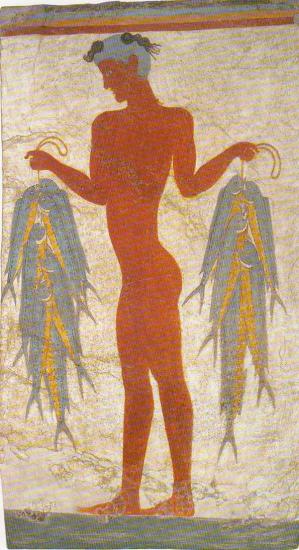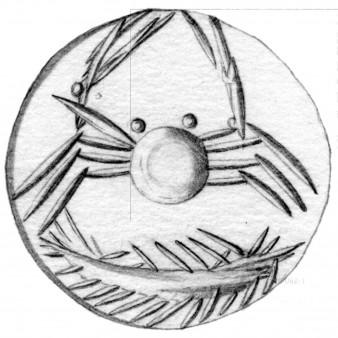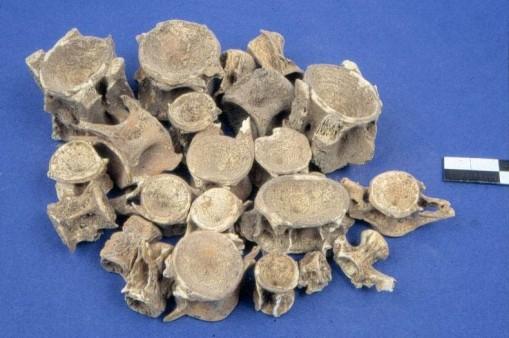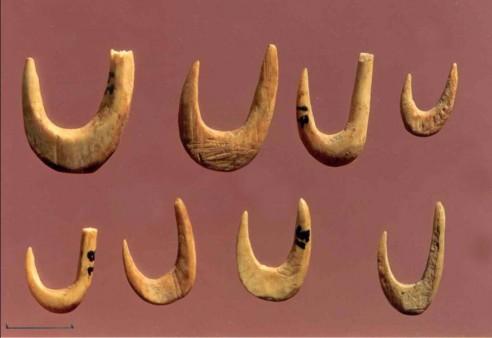Dimitra Mylona / Institute for Aegean Prehistory
Source - http://www.archaeology.wiki/blog/2014/11/24/fish-shellfish-fishermen-prehistoric-aegean/
The coastal communities that lived around the Aegean exploited the riches of the sea from very early in their history. This relationship was expressed with a large variety of fishing ways and choices which reflect the character of the local ecosystems and the interests and priorities of the local communities. The roots of the fishing traditions of the Aegean, which are still found along its coasts, are to be found in prehistoric times, from the Mesolithic to the Bronze Age (note 1).

Fig. 1. “Little Fisherman”. Wall painting, Akrotiri, Thera. The fisherman holds dolphin fish (Coryphaena hippurus) and little tunnies (Euthynnus alletteratus).
The exploration of prehistoric fishing in the Aegean is based on several lines of evidence. Fish bones, sea shells and remains of other marine organisms are regularly found in archaeological excavations and inform us on what people caught and gathered from the sea. The fishing tools, also found in excavations, as well as the illustrations in art inform us on the catches, on fishing techniques and on the people behind the act. Natural sciences, including ichthyology, marine biology, oceanography and ecology add extra dimensions to the understanding of ancient fishing and shellfish gathering. Additionally, anthropology and ethnography provide analogies that help in our quest for the understanding of the inter-relations between humans and aquatic resources.

Fig. 2. Talismanic seal with crab, ca. 1450 BC (CMS VIII 062).
The picture that results from such an approach is fascinating and often, quite detailed. It provides a wealth of evidence which is potentially useful not only to archaeologists but also to ichthyologists and marine biologists. This picture, however, does not represent a snapshot of the ancient aquatic fauna but only that part of it that interests the ancient fishing communities, in other words, it is a picture of the fish and shellfish that were chosen by humans as food, as raw materials or as symbol.
Fish and fishermen in the Mesolithic
The oldest evidence for the systematic, complex and elaborate exploitation of the aquatic resources of the Aegean sea dates to the 11th millennium before present. That was the end of an era of extreme environmental changes and the beginning of the Holocene. This period is conventionally called the Mesolithic and some environmental issues that pertain to this period are important for the fishing activity at the time. It appears that the Black Sea opened to the Aegean and the rest of the Mediterranean just then. This event, in combination to an increased discharge of the large rivers of the Northern Aegean (due to higher precipitation at the end of the Ice Age) led to a marked increase of nutrients concentration in the waters. Culturally, the Aegean coasts were sparsely occupied by communities of hunter-gatherers and fishermen. There is unequivocal evidence that those people were technically able to cross considerable distances between the mainland and certain islands using boats.

Fig. 3. Fish bones form the Mesolithic strata in the Cave of Cyclope, Youra.
Three archaeological sites provide rich data on the issue of fishing and shellfish gathering at this time: the Franchthi Cave in the Argolid, the Cave of Cyclope at Youra and the open air settlement of Maroulas on Kythnos. During their excavation there have been collected tens of thousands of fish bones and scales, sea shells and bones of sea mammals and sea birds.
The fish caught at these sites were mostly inshore (caught in shallow waters near the shore) and of medium size (ca 20-50cm). Groupers, scorpion fishes, John Dories, wrasses but also sea breams of various kinds were among the most common, although there is evidence for the capture of very large fish (>50cm) as well. The excavation in the Cave of Cyclope also produced a number of fish hooks, made of bone and antler. Some of these had already attained the typical, and apparently very successful hooked shape that survived to the present day while the configuration of others, of a bi-pointed shape, has been forgotten in the Mediterranean but survives in other parts of the world. The excavation in the Cave of Cyclope at Youra also produced the remains of euryaline fish (fish that tolerate considerable fluctuations in water salinity), such as the gray mullets and migratory fish, mostly of the Scombridae family. Although they regularly captured large tunas (Thunnus sp.) with a special preference to the medium of small size fish, they mostly targeted the smaller species of the Scombridae family, such as the mackerels, the pelamids, the little tunnies etc.

Fig. 4. Bone fish hooks from the Mesolithic strata in the Cave of Cyclope, Youra.
In this period, the Mesolithic, we have the first evidence for fish preservation. In the osteological material from the Cave of Cyclope we observe that some fish such as the little tunnies (Euthynnus alletteratus) are systematically missing their head bones and their first vertebrae. This suggests that the heads had been cut before the fish were brought to the cave. Such a practice echoes the traditional process of fish preservation, which begins with the decapitation of fish and the removal of the viscera, to avoid quick spoiling of the fish. An interest to the storage of presumably preserved fish, is documented at the coastal settlement of Maroulas on Kythnos, where whole fish were stored in cavities in the floors of the rounded huts. As in Yioura, some of the heads and first vertebrae are missing altogether. The same phenomenon has been observed in other Mesolithic sites on Cyprus and Southern Italy, a fact that indicates the existence of a common Central and Eastern Mediterranean tradition in the preservation of fish.

Fig. 5. Articulated fish skeletons stored in the floor of a Mesolithic hut at Maroulas, Kythnos (Photo: A. Sampson).
PART.2